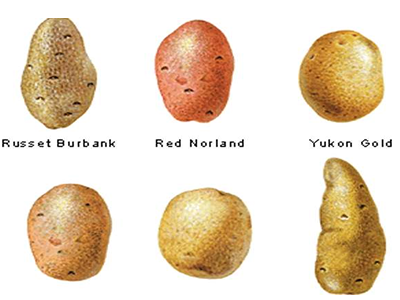How Much Do Know about Potatoes ?
Nutritions:
The potatoes are one of the most nutrient-dense vegetables available and provides substantial nutrition for few kilojoules. To preserve these nutrients
it is important to peel the potato just prior to cooking and not leave it exposed to the air or standing in water any longer than necessary. Australian
Nutritionist's suggest that to retain maximum benefit of the nutrients in potatoes, they should be scrubbed thoroughly and cooked in their skins. If
you prefer to serve potatoes peeled, only the thinnest layer of skin should be removed as many valuable nutrients lie just beneath the skin.
Rich in carbohydrates and energy. A natural source of folate.
Low in calories. Good source of niacin, vitamin B6 iodine and thiamin. No cholesterol whatsoever. Completely fat-free. Great source of protein.
Natural,good-for-you dietary fibre.
Just one medium sized potato, 150g, provides a good proportion of the recommended daily
requirements of many important vitamins and minerals. For an inexpensive, high-energy snack,
cook a potato for two minutes each side in a Potato Micro waver. Served with low-fat toppings, it is the perfect healthy snack no matter what your
lifestyle.
The potatoes are large tubersfood-storing bodies that grow from the end of an underground stem, below the fibrous roots. Each tuber bears several
buds (the eyes of the potato) from which new plants grow.
Potatoes are large tubers that grow from the ends of underground stems
The potato plant grows best in a cool climate, in soil that is well drained and rich in nitrogen. The seeds are cut pieces of tuber, each containing
one or two eyes. The pieces are planted 12 to 18 inches (30 to 45cm) apart in hilled rows 24 to 36 inches (60 to 90 cm) apart. The tubers form 40
to 50 days after planting and mature after 90 to 120 days. Potatoes are harvested in late summer or early autumn. They may be stored for several
months before marketing.
The Colorado potato beetle, flea beetles, leafhoppers, and aphids attack potato foliage, and wireworms feed on the tubers. The potato plant is
subject to viral, bacterial, protistan, and fungal diseases, such as (respectively) leaf roll, blackleg, late blight, and black scurf. Various pesticides
are used to kill potato pests. Some varieties of potatoes have been developed that are resistant to certain diseases.
Varieties of Potatoes

About 100 varieties of potatoes are grown in the United States. They are divided into four categories: round white, long white, russet, and round
red. The leading varieties of round whites are Kennebec and Katahdin.
The leading russet is the Russet Burbank, developed in the 1870's by Luther Burbank. Important varieties of long whites include the Norchip and
Norland; of round reds, the Red La Soda and Red Pontiac.